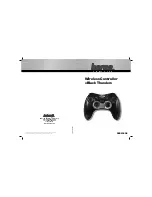
Page 14
Pro-120 controller instructions
15 Waterproofing
The cover is a vacuum forming which is waterproof.
The cased assembly is best mounted with the
heatsink at the bottom: water may run over the
aluminium base with no problem - in fact water on
the base would have to be about 10mm deep before it
touched anything electrically live.
In the mouth of the cover you should fit a splash
plate (supplied with the cover) in the position shown
in diagram 6. The splash plate should be
sealed/glued in place with suitable silicone rubber
(Dow Corning 734 RTV) between plate and circuit
board. Run a fillet of rubber along the top edge of the
plate and push it up to the relays. Leave the assembly
board-side down while the rubber sets so that it runs
down to the circuit board forming a seal. When
supplied as a controller with case, 4QD will fix the
splash plate in position.
The cover has a strip of foam already fitted to help
sealing between cover and board. However you must
not let water get onto the board - at the very least
electrolytic corrosion will occur - so take a moment
to consider what will happen if water runs down the
leads to the controller: put a kink in the leads so
water drops off at that point.
If mounting the controller on its side, remember that
if water gets into the mouth it could sit inside the
controller and could easily touch the circuit board.
Either make sure water cannot enter or else drill a
drainage hole in the bottom side of the cover, at the
mouth, so water can escape. We also suggest you
seal the splash plate to the side of the cover with
silicone rubber.
16 Choice of motor
All speed controllers should only be used with good
quality motors. Motors with damaged, worn
brushgear will causes arcing. On occasion brush
arcing can cause seemingly random controller
failure. This effect is quite rare, but be careful.
Ideally the motor should include an internal
suppression capacitor, a ceramic type of 10n value is
ideal. If the motor does not include this you are
advised to fit one across the brushes as close as
possible to the motor body. The controller will work
without this capacitor, but fitting it can lengthen the
life of the system.
A word of warning: many car type motors have the
chassis connected to one terminal. Take great care
with these as you could easily short the controller out
- which would be fatal. It is best to avoid these
motors. Otherwise either make sure the motor is
mounted on insulation (including the drive shaft), or
make certain that no other point of the control
system can be earthed to chassis.
Most modern d.c. motors use permanent magnets.
These are the best for battery operation. However,
other types can be used: at 4QD we regularly use a
12v car starter motor for testing (even with our 24v
150 amp drives) since these are a far worse load than
is ever likely to be met. Into such a motor (stalled)
the controllers simply deliver their maximum current
and quickly get hot. It is virtually impossible to
damage the controllers by an unsuitable motor (the
controller will simply get hot quickly), so don’t be
afraid to experiment.
There is no reason why you cannot use a 24v motor
from 12 volts - it will only go at half its design
speed. Also, if you use a 12 volt motor from 24v, it
will go at twice its rated speed. Since the Pro is
current limited you won’t overload the 12v motor,
provided it can handle the available (limited) current.
Shunt wound motors are suitable - they react as a
permanent magnet one.
Series wound motors are not suitable for the standard
controller because they will not reverse by normal
armature control.
The nameplate current quoted for motors is normally
a continuous rating: most motors will safely take an
overload of about 400% for short periods.
The current the motor actually requires is determined
by the mechanical loading, not by the controller or
the motor. If the motor is too small, it will overheat
and if the controller is too small, then it will
overheat. For more information on motors see our
www site


































